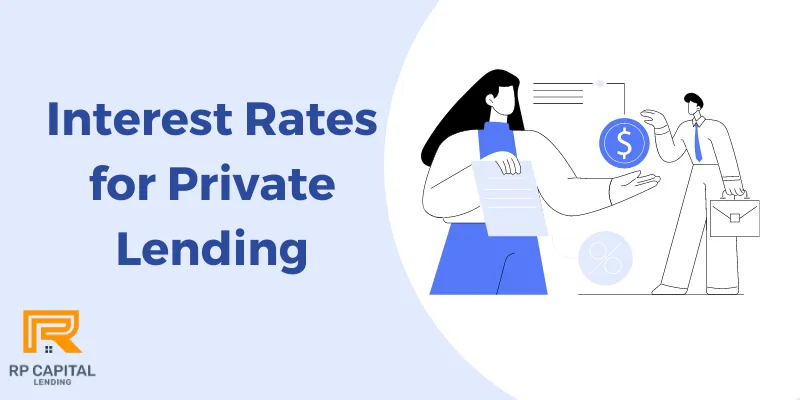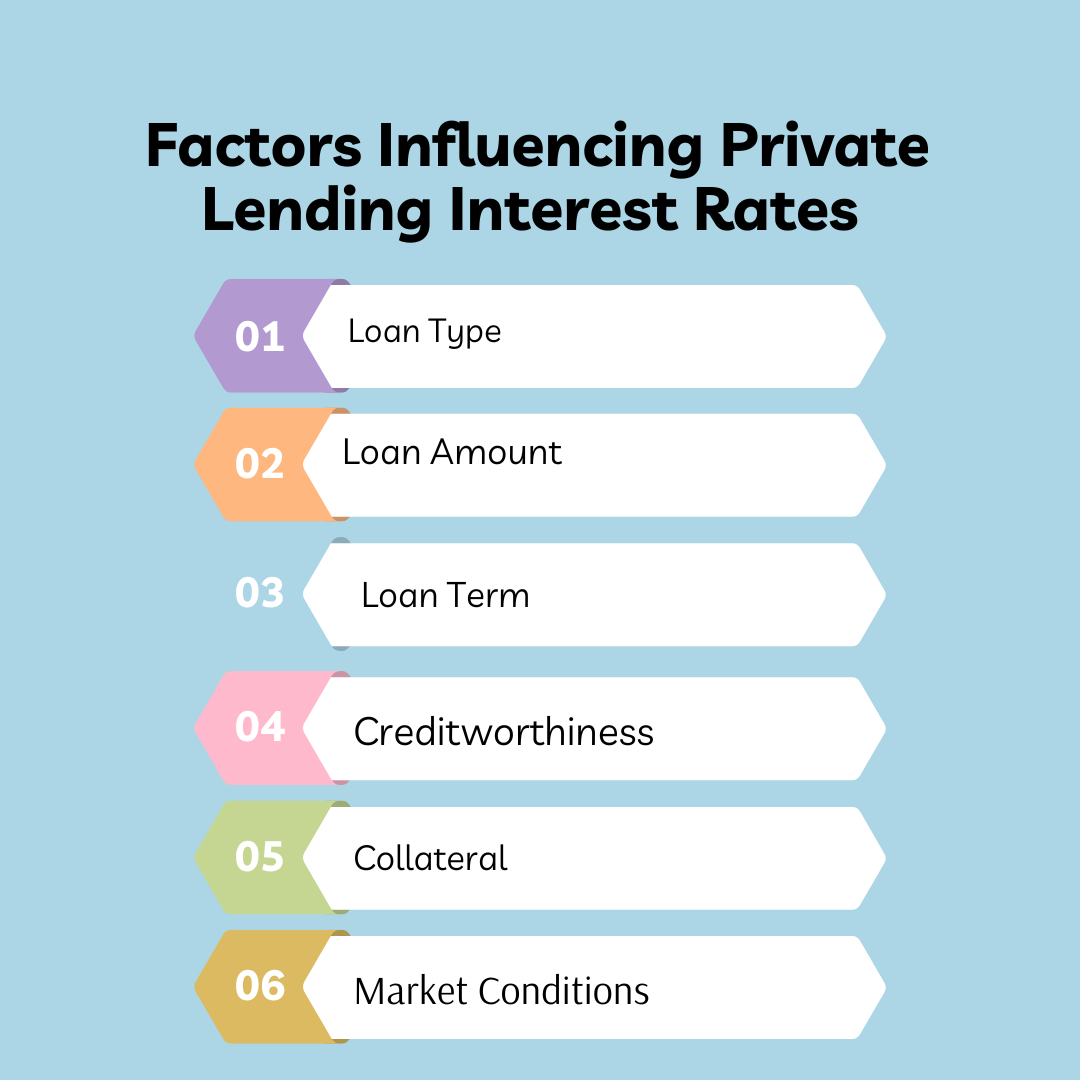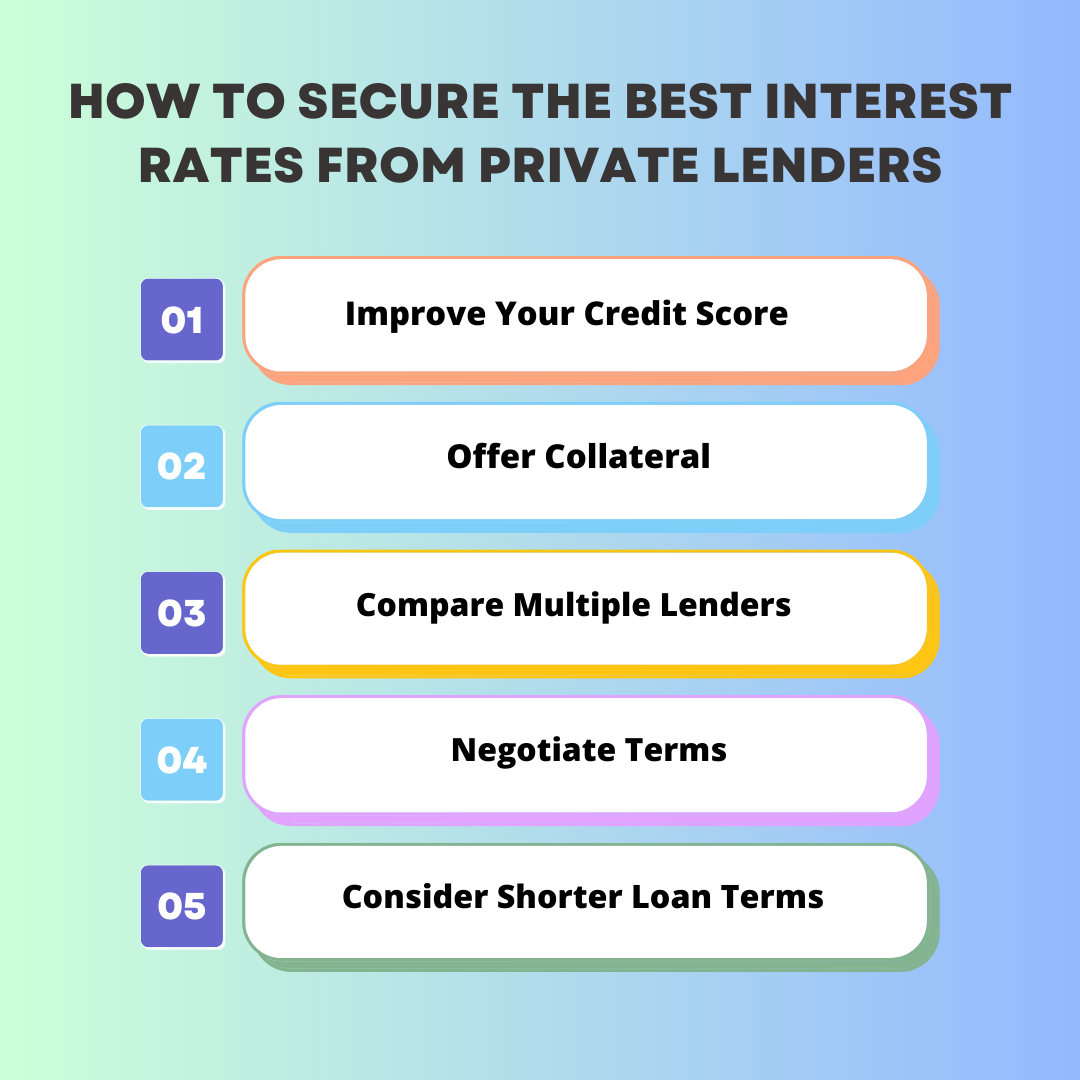Blog

The Ultimate Guide to Private Lending Interest Rates in 2024
When considering private lending, understanding interest rates is crucial. These rates can significantly impact the overall cost of your loan. But what exactly determines these rates?
How do they compare to traditional lending options?
In this guide, we'll explore everything you need to know about interest rates in private lending, covering factors that influence rates, comparison with traditional loans, tips for negotiating better rates, and common questions borrowers often have.
What is Private Lending?

Private lending is a type of financing where individuals or organizations (other than traditional banks or financial institutions) provide loans to borrowers.
Unlike traditional loans, which are typically offered by banks or credit unions, private loans come from non-institutional lenders, such as individuals, private companies, or investment groups.
What Are Interest Rates in Private Lending?
Interest rates in private lending refer to the percentage charged by a private lender on the amount borrowed. Unlike traditional banks, private lenders have more flexibility in setting their rates, often leading to a broader range of options.
This flexibility allows private lenders to cater to a wider variety of borrowers, including those who might not qualify for traditional loans.
However, it also means that borrowers must be more diligent in understanding the terms they are offered.
Key Factors Influencing Private Lending Interest Rates

Interest rates in private lending are influenced by a range of factors. Understanding these can help you anticipate the rates you might be offered and take steps to secure more favorable terms.
1. Loan Type:
Hard Money Loans: Typically used for real estate investments, these loans often have higher interest rates due to their short-term nature and the risk associated with property investments.
Bridge Loans: Designed for temporary financing, bridge loans usually carry higher interest rates because they are short-term and help borrowers bridge a financial gap.
Personal Loans: These can vary widely in interest rates, depending on whether they are secured (backed by collateral) or unsecured (not backed by collateral).
2. Loan Amount:
Larger loans might come with lower interest rates because the lender spreads the risk over a higher amount. Conversely, smaller loans may have higher rates.
3. Loan Term:
Short-Term Loans: These generally have higher interest rates since the lender recoups their investment faster and assumes a higher risk.
Long-Term Loans: Longer repayment periods can sometimes lead to lower interest rates, though this also depends on the overall loan type and lender policies.
4. Creditworthiness:
A higher credit score usually results in lower interest rates, as it indicates a lower risk to the lender.
Poor credit may lead to higher interest rates or even difficulty in securing a loan.
5. Collateral:
Loans secured with collateral, such as real estate or other valuable assets, often have lower interest rates compared to unsecured loans.
6. Market Conditions:
Economic factors, such as inflation, market demand for loans, and the overall interest rate environment, play a significant role in determining rates.
Types of Private Lenders and Their Impact on Interest Rates
Different types of private lenders may offer varying interest rates based on their lending models and risk appetite.
1. Individual Private Lenders:
These are individuals who lend money as an investment. They may offer more flexible terms but could also charge higher interest rates due to the personal risk they assume.
2. Private Lending Companies:
These companies specialize in private loans and often have more standardized interest rates. They may offer lower rates compared to individual lenders but could have stricter qualification criteria.
3. Peer-to-Peer (P2P) Lending Platforms:
These platforms connect borrowers directly with investors. Interest rates can vary widely depending on the borrower’s profile and the investor’s appetite for risk.
Comparing Private Lending Interest Rates with Traditional Lending
Private lending rates are generally higher than those offered by traditional banks. This section will help you understand why that is and when it might still be worth considering private lending.
1. Risk Assessment:
Traditional banks have stricter risk assessment processes, which often lead to lower interest rates for qualified borrowers. Private lenders, however, are more willing to take on higher-risk loans, which justifies their higher rates.
2. Approval Speed:
Private lenders can process loans faster than banks, often approving and disbursing funds in a matter of days. This speed comes at a cost, reflected in higher interest rates.
3. Flexibility:
Private lenders are typically more flexible with loan terms, which can be advantageous for borrowers with unique needs or circumstances. However, this flexibility is often balanced by higher interest rates.
How to Secure the Best Interest Rates from Private Lenders

Even with the higher rates typically associated with private lending, there are strategies you can use to secure the best possible interest rates.
1. Improve Your Credit Score:
Paying down existing debt, avoiding new credit inquiries, and making all payments on time can help improve your credit score, leading to better loan offers.
2. Offer Collateral:
Providing valuable collateral can reduce the lender’s risk, leading to lower interest rates. Real estate, vehicles, and other high-value assets are commonly used.
3. Compare Multiple Lenders:
Don’t settle for the first offer. Shop around and compare rates from multiple private lenders to find the best deal.
4. Negotiate Terms:
Some private lenders are open to negotiation, especially if you have a strong credit history or can offer substantial collateral.
5. Consider Shorter Loan Terms:
While it means higher monthly payments, opting for a shorter loan term can result in lower interest rates overall.
The Risks and Rewards of Choosing Private Lending
Private lending offers unique advantages, but it also comes with risks that borrowers should be aware of.
Advantages:
Quick Access to Funds: Private loans are typically processed faster than traditional loans, making them ideal for urgent financial needs.
Flexible Terms: Private lenders often tailor loan terms to fit the borrower’s specific situation, offering more flexibility than traditional banks.
Easier Approval: Private lenders may approve loans for borrowers with poor credit or unconventional financial situations.
Risks:
Higher Interest Rates: The flexibility and speed of private lending come at a cost, usually reflected in higher interest rates.
Less Regulation: Private lenders are less regulated than traditional banks, which can lead to less favorable loan terms if not carefully reviewed.
Potential for Default: Borrowers with less stable financial situations may struggle with the higher interest rates, increasing the risk of default.
Conclusion
Interest rates in private lending can vary widely based on a range of factors, including loan type, amount, term, and the borrower's creditworthiness.
By understanding these factors and knowing how to negotiate with lenders, borrowers can secure more favorable terms. While private lending offers unique advantages like flexibility and quick approval, it's essential to weigh these against the higher costs involved.
FAQs
1. What is the average interest rate for private lending?
The average interest rate for private lending typically ranges from 6% to 15%, depending on the type of loan, the borrower’s creditworthiness, and other factors. Rates may be higher for riskier loans or shorter-term financing.
2. How can I lower my private lending interest rate?
You can lower your interest rate by improving your credit score, offering collateral, or opting for a shorter loan term. Additionally, comparing offers from multiple lenders can help you secure the best rate available.
3. Are private lending interest rates fixed or variable?
Private lending interest rates can be either fixed or variable, depending on the loan terms. Fixed rates remain the same throughout the loan term, while variable rates can change based on market conditions.
4. Why are private lending rates higher than traditional loans?
Private lending rates are higher because private lenders take on more risk, particularly when lending to borrowers who may not qualify for traditional bank loans. The flexibility and speed of private lending also contribute to the higher rates.
5. Is private lending a good option if I need quick funding?
Yes, private lending can be a good option for quick funding, especially if you need to secure a loan faster than traditional banks can offer. However, be prepared to pay higher interest rates for this convenience.
RP Capital Lending is a d.b.a of RP Capital Partners Inc (NMLS # 2469193) | Privacy Policy
Copyright © 2022. All Rights Reserved.
Disclaimer: Loans only apply to non-owner occupied properties. Rates, terms and conditions offered only to qualified borrowers, may vary upon loan product, deal structure, other applicable considerations, and are subject to change at any time without notice.

